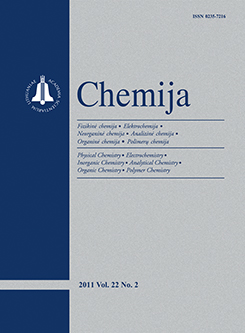Chemija / Chemistry
WHAT?
 ISSN 0235-7216 ISSN 2424-4538 (online) |
2016 m. Nr. 1 Porous anodized aluminium oxide: application outlooks
Properties of nanomaterials often differ from the ones of macrosized materials, and many of them have to be investigated. As one of the example is the formation of porous anodic metal oxides. An oxide film can be grown up on certain metals by anodization, the so- called valve metals. For each of these metals there are conditions established to enable promotion of the formation of thin, dense, barrier or porous oxide having uniform thickness at the whole surface. Among valve metals aluminum is an important case because of its ability to find diverse and important applications including architectural finishes, prevention of corrosion of automotive and aerospace structures, and electrical insulation. The porous aluminium anodic oxide (AAO) collected an enormous attention, because its pores can be used as a template for preparing various nanomaterials as nanoparticles, nanowires and nanotubes. The most widely used baths contain sulfuric acid, for particular applications oxalic or phosphoric acids are also used. It has been widely accepted mechanism that the formation of pores in anodized metal oxides is based on two continuous processes, one is oxide dissolution at the electrolyte/oxide interface and the other is oxidation of metal at the oxide/metal interface. This work presents an overview on fabrication research, understanding the formation mechanism of anodic metal oxide and the application of different sized AAO materials.
: Keywords: anodic aluminium oxide, macro- and nanosized oxide, sulfuric, oxalic and phosphoric acids, mechanical and tribological properties, electrodeposition, wettability |
Issues:
2017 - Vol.28 No. 1, No. 2, No. 3, No. 4 2016 - Vol.27 No. 1, No. 2, No. 3, No. 4 2015 - Vol.26 No. 1, No. 2, No. 3, No. 4 2014 - Vol.25 No. 1, No. 2, No. 3, No. 4 2013 - Vol.24 No. 1, No. 2, No. 3, No. 4 2012 - Vol.23 No. 1, No. 2, No. 3, No. 4 2011 - Vol.22 No. 1, No. 2, No. 3, No. 4 2010 - Vol.21 No. 1, No. 2-4 2009 - Vol.20 No. 1, No. 2, No. 3, No. 4 2008 - Vol.19 No. 1, No. 2, No. 3-4 2007 - Vol.18 No. 1, No. 2, No. 3, No. 4 2006 - Vol.17 No. 1, No. 2-3, No. 4 2005 - Vol.16 No. 1, No. 2, No. 3-4 2004 - Vol.15 No. 1, No. 2, No. 3, No. 4 2003 - Vol.14 No. 1, No. 2, No. 3, No. 4 2002 - Vol.13 No. 1, No. 2, No. 3, No. 4 2001 - Vol.12 No. 1, No. 2, No. 3, No. 4 |